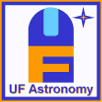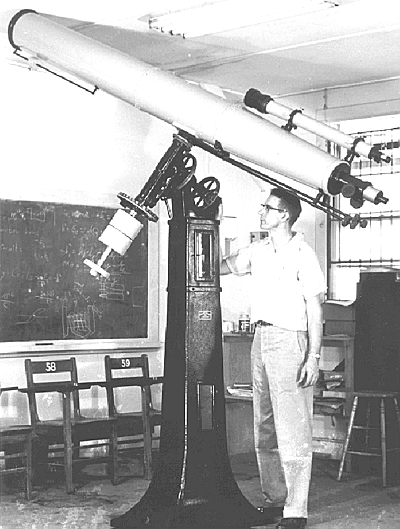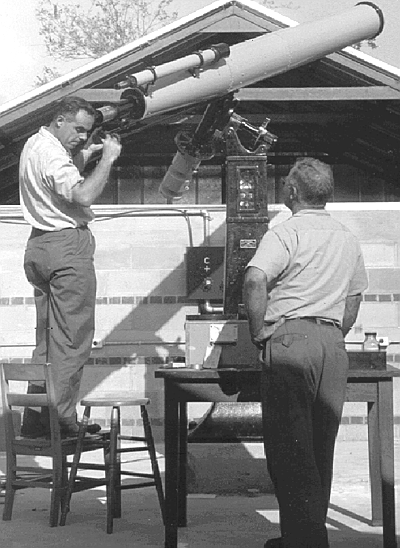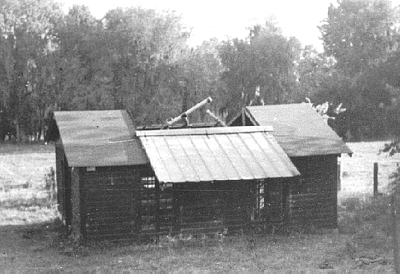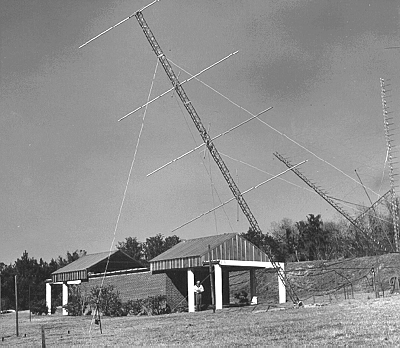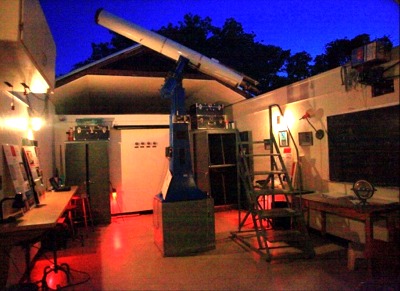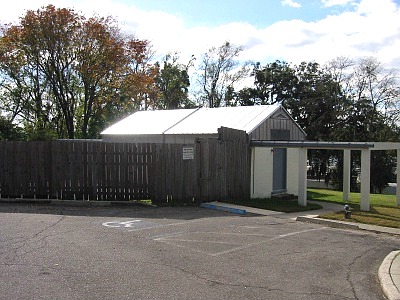|
|
Ye Stars! Which are the poetry of heaven – Lord Byron (1788-1824) |
Text prepared by Prof. Alex G. Smith
September 1998
Additional text at end by Prof. Howard L. Cohen on history from 1980–1985
(Also see Announcement of Opening for Public Nights)
[Click each figure for a larger version]
|
Until the end of World War II, the University of Florida's interest in astronomy seems to have been confined to one elementary course in descriptive astronomy and a course in navigation. The Department of Mathematics was responsible for these offerings, which were passed around among various instructors. Astronomical topics, with a strong emphasis on history, were also included in the physical science course C-2, taught in University College, which in that era included all freshmen and sophomores. During the 1930s, a small wooden student observatory was erected on the hillside south of the present Campus Police station, then the home of the campus radio station, WRUF. With a slide-off roof, the observatory sheltered 3-inch and 4-inch refracting telescopes, seen in Figure 1. By 1948 the roof no longer opened, and one could easily kick a hole in the rotting walls Such was the fate of the University's first teaching observatory. During the early 1950s, Dr. Leonidas Roberts, from the Physical Sciences unit, and the present writer conducted weekly observing classes for Physical Sciences students on the hilltop above the defunct observatory. These open-air labs utilized a homemade 8-inch reflecting telescope with optics ground and polished by the writer; this was later supplemented with a 6-inch reflector similarly fabricated by Dr. Roberts under the writer's guidance.
The year 1955 marked the real beginning of the present Teaching Observatory. In that year, Dr. Guy Omer, chairman of Physical Sciences, obtained a gift of a classic 8-inch refractor manufactured by Alvan Clark, the internationally famous American optician. The instrument was built for a wealthy Chicago architect, Richard E. Schmidt. Although he was an amateur, Schmidt used the telescope to measure binary stars in collaboration with the noted Yerkes astronomer S.W. Burnham. The telescope, which sat idle on exhibition at the Adler Planetarium for many years, was rebuilt and refurbished by the writer, with the able assistance of Physics shop personnel Hans Schrader and George Harris. A nerve-racking element of the process was the unavoidable disassembly and bathing of the priceless objective lens. Figure 2 shows Schrader with the instrument assembled in temporary building F behind the old Physics building, Benton Hall. (Benton Hall was torn down in the mid-1960s. Grinter Hall now stands in the same location. A new Benton Hall sits just east of Mechanical Aerospace Engineering.) In late 1956, newspapers throughout the State announced the opening of a new Teaching Observatory at the University to house the Clark refractor. Funding for the $5000 brick building was provided by University Vice President John Allen, himself educated as an astronomer. The design was a joint effort by the writer, Omer, Roberts, and Calvin Green, director of the Physical Plant Division, which performed the actual construction on the site of the original Teaching Observatory. Mr. Green himself was responsible for the design of the ingenious water-driven piston that has opened and closed the heavy metal sliding roof for 42 years. Figure 3 shows the writer and Physics machinist Bud Pennell checking out the Clark during its installation in the new Observatory. In 1956, Mrs. Fred Heath gave the Observatory a 10-inch reflector constructed by her late husband, a professor of Chemistry. This second instrument was also rebuilt by the writer with the assistance of Schrader and Harris.
|
Continuous heavy student use of the Teaching Observatory began in 1956. Until 1969 it was shared by Physical Sciences and Astronomy, but the steadily increasing load of Astronomy students finally made other arrangements imperative. In 1969, Physical Sciences installed a 10-inch Celestron telescope on the roof of the recently completed Little Hall and generously ceded The Teaching Observatory to the joint Department of Physics and Astronomy. (Somewhat predictably, the rooftop facility was not very successful.) By 1971, over 500 students per year were taking regular weekly classes in the Teaching Observatory, which even then was beginning to be threatened by encroaching buildings and lights. (Some are surprised to learn that astronomers speak of light pollution in the same sense that fellow environmentalists speak of other man-made threats to the natural environment!)
When a radio astronomy research program was initiated in 1955 by the writer and Professor (at that time graduate student) Tom Carr, the first antennas were erected on the Teaching Observatory site and the receivers and recorders were sheltered in the Observatory building. Figure 4 shows the Observatory surrounded by the "antenna farm." By 1958, the Radio Observatory had outgrown the small Teaching Observatory site, and it was relocated to a much larger area on agricultural land on the north shore of Bivens Arm. In 1972, the Teaching Observatory itself was displaced to make room for (of all things!) a telephone exchange (Centrex). Under the guidance of Professor John Oliver, the sliding roof was reinstalled on an essentially identical brick building at a new site near the Mechanical Aerospace Engineering Building (Bldg. #725), overlooking the sewage plant, where it has remained to the present day. See Note #1 below about the building's orientation and the Clark 8-inch pier. Once more, the Observatory was threatened by the encroachment of lights and buildings, notably a huge new Physics building to the immediate west. Nevertheless, despite these serious environmental problems, the Observatory nevertheless enjoyed substantial improvement in recent years. (See additional notes at end on history from 1980–85.) Thanks to the vision and generous cooperation of Mr. Bob Cremer, then Director of the Physical Plant Division, needed repairs were made to the structure of the building, and a concrete pad with piers for the 6 portable Meade telescopes was constructed beside the Observatory. The generosity of Professor Stan Dermott, then chair of Astronomy, made possible the purchase of a state-of-the-art, computer-controlled 12-inch Meade reflector whose "go-to" capability now allows us to locate fainter objects even in the degraded condition of the present site. Acquisition of a digital CCD camera, useable on any of the telescopes, makes it possible to demonstrate modern methods of imaging to students and the public. Thanks largely to the efforts of Professor Oliver, the Heath telescope was replaced by a fine 12-inch reflector originally built for the Army Map Service. The Teaching Observatory provides laboratory classes for 800 elementary students each year, together with a smaller number of students in advanced courses. The popular Friday night "open houses" for the general public accommodate an estimated 2500 visitors per year. Special events such as a bright comet or an opposition of Mars attract hundreds of visitors on a single night. Can a small, sea-level observatory in a less-than-ideal location really provide quality viewing? A partial answer is provided by the final illustration, a digital photograph of the great lunar crater Clavius made with the 12-inch AMS reflector. A very similar photo by the famous 200-inch Mt. Palomar telescope shows no details that are not present in the Teaching Observatory image! Note #1 The original, rectangular observatory building behind the police station was oriented with its long axis East-West. When moved to the new site next to Aerospace Engineering (circa. 1971), the walls were rebuilt orienting the long axis of the building North-South. (The roof and water hydraulic opening mechanism were moved to the new site and place on the new walls.) Forgetting that the building orientation had been rotated by 90 degrees, the pier for the 8-inch telescope was installed still pointing toward the short axis of the building, which originally had a North-South orientation! This of course, now made the polar axis point in an East-West direction rather than North-South. Rather than demolish the concrete base on which the metal pier stood, Professor Oliver decided to cut the metal pier below the equatorial head. He then rotated the equatorial head 90 degrees and bolted the head onto the lower section of the pier, an ingenious fix to this problem! Next time you visit the observatory, look carefully at the pier for the 8-inch Clark refractor and notice that the equatorial head is rotated 90 degrees with respect to the rest of the pier! [H.L. Cohen as told by J.P. Oliver] |
Prof. Howard L. Cohen
Text Prepared January 1999, Revised April 2011
(Professor Cohen was Director of the Teaching Observatory and Introductory Laboratory Program from 1980 to 1985)
|
Beginning in 1980 the Department of Astronomy began a program to renovate the Teaching Observatory. The observatory suffered from neglect and lack of modernization making it poorly suited for student or public use. In fact, public use was impossible given the poor state of the building and 8-inch telescope. For example, the building had no insulation and moisture and high summer temperatures had clouded telescope lenses. In addition, the telescope drive, slow motions and clamps no longer worked properly. Setting circles were illegible and few good eyepieces could be found. The metal roof had no ventilation and the roof mechanism needed repair. Sidewalk lighting was also insufficient while campus lights, especially from adjacent buildings, flooded the observatory. Finally, the building had a general rundown appearance. Over the next several years the building was renovated, the 8-inch telescope repaired, and a second observatory instrument installed. Some improvements to the building made during the early 1980's included installing weather stripping and thresholds on doors and door steps, moisture proofing the concrete block walls, thermally insulating and ventilating the roof structure, installing an insulating mechanism to the movable roof structure, installing a wall air conditioner to provide thermal and moisture control, and painting the walls and floors. Safety walk lights, dimmer switches and fencing were added including a chain link fence on the south side of the site to prevent accidental falls to the old dump site below. Repairs were made to driveways and walks leading to the observatory and ground level, and white and red lighting installed. Trimming was done to neighboring trees to allow a better view of the sky. Finally, the physical plant department placed an eight-foot high, solid wood fence around the north and east perimeters of the site to block wind and prevent outside lights from illuminating the observatory area (Fig. 5). The fence also had a large gate with an extra two-foot high extension to block lights from Florida Field. The fence gave the observatory the appearance of a "fort" and, during the 1980's, the Teaching Observatory was often called "Fort Cohen"! (Graduate students even erected a sign with this name over the "fort's" gate.)
Metal piers with electric power for portable Schmidt-Cassegrain telescopes were added on the grassy area outside the east observatory wall. Later, the physical planet department unfortunately removed the protective fence in the 1990's when they added a concrete surface on the east side of the building for the exterior piers. The replacement fence remains unfortunately shorter than the original fence and does a poorer job of shielding the building from outside lights. |
Major restoration was also done to the observatory's historic 8-inch Clark refractor (Fig. 6). The objectives of both the 8-inch telescope and its 3.25-inch finder were removed and shipped to the R.E. Brandt Lens Works in Prescott, Arizona in 1981 where they were dismantled, cleaned and reassembled. Mr. Brandt found the 8-inch lens was badly out of collimation and both objectives had become cloudy with age. The sectional telescope tube was also disassembled so shop personnel could strip and repaint each section of the tube. In addition, shop workers removed the paint from the telescope's focuser and the 3.25-inch finder's tube. Both had been made of brass metal, which should not have been painted. The shop also cleaned and added white color to the setting circle markings, which had become illegible. Painting the large, metal telescope pier proved more difficult. The pier was too large for the shop to sandblast so the heavy pier was transport to the east side of Gainesville where a company that made cemetery monuments sandblasted and primed the pier for repainting! Meanwhile, shop engineers repaired the telescope's drive, slow motion controls and clamps. The Teaching Observatory also needed a second, major instrument for student and public use. (When the Department moved the observatory in the early 1970's, a second, concrete base was added in the building for a another instrument.) The Liberal Arts and Sciences Student Council donated several hundred dollars toward this project. In fact, the Department had parts in storage from several reflecting telescopes including a 12.5 inch mirror! The mirror was shipped off for resurfacing. Meanwhile, astronomy graduate student Gregory Fitzgibbons assembled a complete Cassegrain telescope from the various telescope components on hand and erected the completed telescope on the empty, concrete pad. After years of hard work by graduate students, shop personnel, and physical plant staff, and delays caused by limited monies for this project, the renovated observatory was finally ready for its first public night showing in the fall of 1985. An article in the Gainesville Sun (October 24, 1985, pg. 1A) announced the Teaching Observatory would begin holding public viewing sessions Friday nights from 8:00 to 10:30 p.m. beginning November 1. This began the first, continuing public night series at the Teaching Observatory. And these public viewing sessions have continued ever since then! |
Note #2: Unfortunately, the present observatory site has become very congested and filled with bright campus lighting. In addition, observatory usage on this part of campus is no longer commensurate with the University's master building program. The Teaching Observatory must ultimately move again. This time preservation of the priceless and historic Clark refractor must go hand-in-hand with building a facility appropriate for twenty-first century needs. The Department hopes monies will come from enlightened, public-spirited people who understand the educational and inspirational value of a teaching and public observatory.
